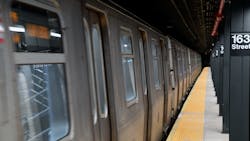MTA train speed and safety task force announces preliminary findings
Subway train speeds on certain sections of track can be increased as much as 50 percent, according to the preliminary findings from the Metropolitan Transportation Authority’s (MTA) Train Speed and Safety Task Force.
The task force initiated a study with engineering firm STV, with the help of Transport Workers Union, that remains ongoing but has already determined four core areas of focus that would lead to faster trains while prioritizing customer and employee safety.
The task force’s initial work examined stretches of track from 14 St to 34 St-Penn Station on the Seventh Avenue 1, 2, 3 lines and in Manhattan to the 34 St-Hudson Yards terminal of the Flushing 7 line. The task force determined the following areas of focus to identify tracks where speeds could be safely raised: Reducing running times through straight tracks and interlockings; improving running times through curves; alleviating bottlenecks and fine-tuning schedules to optimize train movement; and updating speed signage to increase train operator confidence.
The next step is for the task force to examine appropriate and safe speed limits using train operation testing in actual conditions to determine running speeds in different configurations.
“Our modern trains are better designed than our older fleet, and we have new tracks and continuous welded rail, better water drainage, improved electric service and interlockings, all of which means we can safely increase speeds beyond those set 20 years ago,” said MTA Managing Director Veronique Hakim. “Our work continues, and we are committed to drastically improving service and increasing the reliability of the system for all customers.”
The New York subway system was built more than 100 years ago, and to provide for safe operations, various measures were implemented to ensure that trains did not go faster than the conditions they could handle. Two fatal incidents at 14 St-Union Square in 1991 and on the Williamsburg Bridge in 1995 cumulatively led to subway trains operating at slower speeds. Later, the NTSB concluded in both cases the accidents were mainly due to operator error, however, localized system and signal issues were also discovered. At the same time, the MTA never completed the comprehensive speed and safety review they had commenced and thus the trains remained operating at slower speeds with actual devices installed to limit train acceleration.
The slowdown was further compounded by the practice of train operators controlling trains, some of whom believed that the signal system was not properly calibrated, at speeds below the posted limits due to the perception they would be unfairly penalized. The result led to operators driving even slower than posted speed limits. Over the decades, car design and track geometry have improved, allowing cars to maintain stability and safe operation at higher speeds, but the speed limits were not changed to reflect these advancements in safety and comfort.
Under the task force’s preliminary recommendations, New York City (NYC) Transit will coordinate with the TWU to ensure that mis-calibrated timed signal timers have been fixed and that operators will not be penalized. Overall, the task force’s findings build on the success of NYC Transit’s Save Safe Seconds effort to increase subway speed limits by locating and fixing mis-calibrated signals in parts of the system. The task force’s continuing work will expand the number of locations where speeds could be raised and increase operator confidence thanks to coordinated efforts with NYC Transit’s labor partners.
“As a former federal regulator, I understand that the safety of the more than 5.6 million people who ride on North America’s largest mass transit system is of paramount importance,” said former U.S. Federal Aviation Administrator and task force chair Jane Garvey. “The goal of this study has been - and always will be - to increase reliability in the system, reduce running times, but all while ensuring that riders who rely on the subways will reach their destinations safely. I am extremely confident that the recommendations the task force is making today are a huge step towards achieving these goals and I look forward to continuing this important work.”
Final recommendations from the task force will be sent to MTA Chairman Patrick Foye for review and approval by the end of 2019.
“The task force’s work builds on the success of the efforts NYC [Transit] has underway by identifying new opportunities to deliver more benefits for our millions of daily riders,” said Sally Librera, senior vice president for subways, NYC Transit. “With safety as our top priority, we’re doing everything we can to improve operations as we work toward modernization. “
